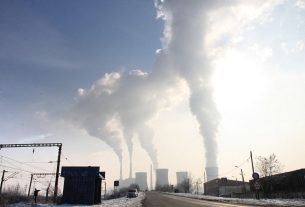Mark Vellend, from Université de Sherbrooke, and Hasanki Gamhewa, from the Ministry of Natural Resources of Ontario, Canada, discuss their article: The duration of high spring light for understory plants: Contrasting responses to spatial and temporal temperature variation
Early spring is the best time for field work in the deciduous forests of southern Québec. The bitter cold of winter is behind us, but the heat of summer is still a couple months away. There is sunshine in the forest understory (paradoxically) and the black flies and mosquitoes that will later drive us crazy have yet to emerge.
For a handful of herbaceous understory plants, early spring is also their time to shine. Emerging in late April or early May, they can exploit the abundant light for a few weeks before that light starts to be intercepted by trees and reduced to just a small percentage of what you would measure in full sun.


Trout lily (Erythronium americanum, top) and red trillium (Trillium erectum, bottom) growing in the sunlight of spring, as the leaves of canopy trees above them are just starting to emerge. Photo credits: Mark Vellend.
It is common knowledge that if warm conditions arrive earlier than usual in spring, plants will generally also emerge and leaf out earlier than usual. That is, the timing of a plant’s annual cycle – phenology – is sensitive to climate. But what if the understory plants (who need that high spring light) and the trees (who will take most of it once they leaf out) are differentially sensitive to climate? If a warm spring prompts an understory plant to emerge a week earlier than usual, while the trees leaf out two weeks earlier than usual, that’s one week less of light for the understory plant. If it’s the understory plants who respond more strongly, we expect the opposite result: a longer period of high light availability in the understory.
Circa 2017 we knew of no studies testing whether warmer conditions – anticipated under climate change – were associated with shorter or longer periods of high light (or neither) in the understory. So, we set up a network of cameras to follow the phenology of two understory plants (red trillium and trout lily) and the canopy trees above them along an elevational gradient in Parc national du Mont Mégantic.


After just a couple years of data were in, two undergraduate students – Antoine Plourde-Rouleau and Valentine Glaus – conducted small research projects analyzing data for each of the understory species. To carry this project to completion, M.Sc. student Hasanki Gamhewa made the long journey from Sri Lanka to Québec. She applied to the M.Sc. program in January 2020, just before the Covid-19 outbreak was declared a pandemic. One can well imagine responding to the pandemic by deciding to just stay home, but Hasanki was not to be deterred. After repeated delays and a period of quarantine, Hasanki finally got going on her research in early 2021. With a helping hand from Ph.D. student Anna Crofts (for statistics) and Charlotte Brown (for climate data), Hasanki pulled all the pieces together to reveal some fascinating results.

Based on temperature fluctuations year-to-year, it appears that while the understory plants remain growing under the same tree species, warming will increase the duration of high light they can exploit in the spring. However, based on results across the elevational gradient, the combination of warmer temperatures and a change in dominant deciduous tree species, which we might expect over the longer term, it looks like the period of high light might shrink. Adding one more layer of complexity, such a long-term change in tree species – more deciduous species, fewer conifers – is likely to increase the overall amount of light available in spring. Taken together, it seems that climate warming should give these understory plants a boost by prolonging or increasing their access to sunlight.
Our cameras are still clicking away in the forest, so we’ll have to see what they reveal in the coming years.

